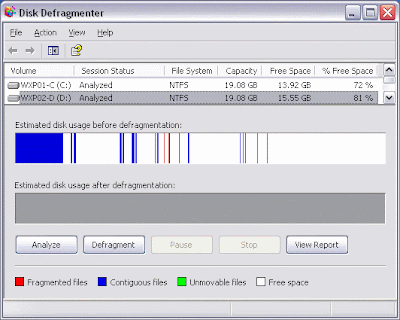

The high-resolution images consume a lot of drive space. Medical records, X-rays, MRIs, CTs and ultrasounds are being stored on the SAN and are accessed heavily by doctors and nurses. “Our servers are able to search the databases for images much easier and more fluently.”Ī lot of data at the hospital is moving constantly. “We have seen much better performance on data transfers,” said Barnes. When Matthew Barnes, a hospital systems administrator, loaded some defrag trialware on one server, he was shocked at the number of fragments. Adding more RAM and another processor gave some relief, but performance continued to struggle. Query times on these servers were getting longer. The first hint of trouble came from an application running a massive Oracle database. Many of these systems had gone years without ever having been defragmented.
#Diskkeeper run defrag windows#
These serve more than 200 Windows servers, a few Linux boxes, one OpenVMS and one AS/400 system. All are setup with RAID 50 and two hot swappable drives. All of its iSCSI arrays have 14 drives some have 250GB hard drives while others have 760GB hard drives. But it also has one Fibre Channel (FC) array (HP StorageWorks EVA SAN), which is required for one of its applications.

Thomas Memorial Hospital in South Charleston, W.V., relies mainly on an iSCSI SAN due to cost and ease of set up. “I can run all of the servers at once without any issues, but if I stop Diskeeper even for a very short time, everything really slows down in a hurry,” said James Moore, operations and maintenance at Boeing. From his experience, no noticeable resources are consumed in running it. Moore found more than 13,000 fragments on one Windows machine when he installed the defrag utility. Data is stored on some EMC disk arrays and an HP StorageWorks EVA SAN. James Moore, an operations and maintenance specialist at Boeing, has more than a dozen Windows servers running SQL Server, Windows Server 2003, and various business applications. Boeing Defrags WindowsĪerospace giant Boeing is another company running defragmentation in a SAN environment. He said he experienced an 80 percent application performance increase from defragmentation of his drives.


This creates a ton of fragmented files, whether they are on VMs or physical file servers. In his environment, a lot of temporary files are being created and deleted all day long. On average on each of these machines, he reported having to clean up about 7,000 fragments daily. On the HP arrays, some of the servers were 90 percent fragmented. For the EqualLogic arrays, it runs inside the virtual machines running on those boxes.īucci said he had observed a steady deterioration of performance over time. In the case of the HP arrays, Diskeeper is running on the servers attached to the SANs. According to Kenneth Bucci, a technical support specialist at the firm, customer complaints about performance ended when the company added Diskeeper’s defragmentation solution. Synectics Group of Allentown, Pa., has a 2TB HP MSA1000 and two Dell EqualLogic SANs, one 4TB and the other 3.5TB. Whether fragmentation affects storage area networks ( SANs) is a matter of debate, but users nonetheless claim performance benefits from using defragmentation solutions in their data storage environments (see Does Fragmentation Hurt Storage Network Performance?).


 0 kommentar(er)
0 kommentar(er)
